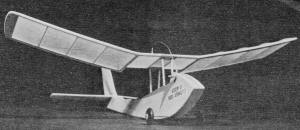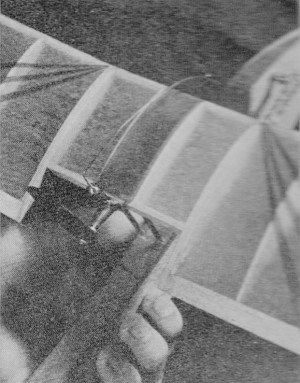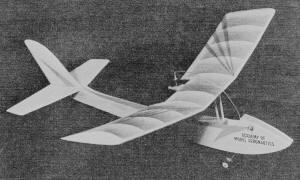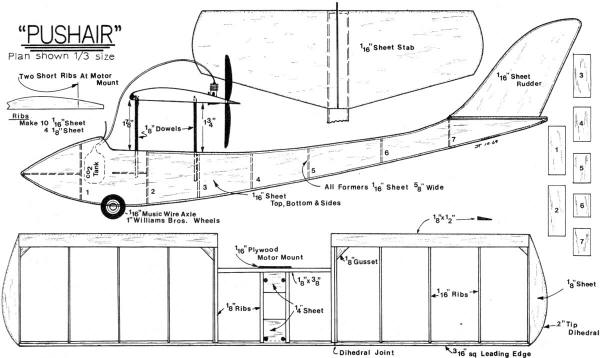|
Website
visitor Tom J. wrote to request that this article for the "Push-Air"
CO2-powered free flight
model be posted. Designed by Frank Ehling, it appeared in the February 1970
edition of American Aircraft Modeler. The 19" wingspan almost seems large
for such a tiny motor - the 0.005 cubic-inch Brown Junior CO2.
Built-up stick and tissue construction could replace the 1/16" sheet balsa
fuselage sides and tail surfaces to save a little weight if you want a little
extra flight time. See the "Fizz-Wizz"
article from the March 1962 American Modeler and my
DP-03 CO2 motor. Push-Air
CO2-Powered Free-Flight
For the new Brown Junior .005 CO2 engine, a wee cutie
that can be flown in parks - or even indoors! Frank
Ehling

Patterned after the old Curtiss-Wright Junior, Push-Air is an extremely
stable, slow flyer, thanks to its parasol wing.

The wee engine is merely cemented to the firewall. The firewall cements
to the trailing-edge center-section. No bolts - not even fuel-proof
cement needed.

CO2 containers are hidden in spacious nose.
CO2-powered models are not new. Herkimer and Campus once mass-produced
such engines, and CO2 power was once a National contest event.
The model shown here was made overnight to demonstrate a new motor.
Now Bill Brown, of the famous Brown ignition engines of the 1930's and
early 40's, has come up with another winner - a tiny "mill" called the Brown
Junior .005 CO2. Its displacement is .005, or 1/200 cu. in. Weight
is 1/10 oz. with hardware. The engine can be run at various speeds; it's
a simple job to turn the head to adjust to the rpm desired. Price is $24.95
with tank. The loader costs $5.95 but also can be used with the Brown jet
engine, available later. One big advantage over a glow engine, of
course, is lack of noise; great for those who have to fly in a city park.
Another advantage is its cleanliness of operation. It allows one to make
a simple model and not accumulate weight with a lot of fuel-proof dope which
can warp light structures, causing all sorts of flying trouble. Furthermore,
piston-powered indoor flying is again possible. Push-Air is simple
to build. Use light balsa throughout. Build the fuselage by cementing the
bulkheads to one fuselage side while it is lying flat on the workbench,
and then cement the other side on top and weight it down until dry. Then
sheet cover the top and bottom of fuselage. The dowel wing struts are simply
poked through the fuselage top, and cemented. After the wing is
built and covered with tissue, paint with dope that has been cut 50% with
thinner. Make the holes in the 1/4" sheet to accept the other end of the
wing struts, and cement well. The engine is just cemented to the plywood
engine firewall, which is cemented to the center of the trailing edge. Slip
the CO2 containers in place and cover that portion of the fuselage.
A simple wire axle with wheels is cemented directly to the bottom of the
fuselage. Use several coats of cement. Flying is easy. Using thrust
adjustments for turn, do remember that on a pusher, the down-thrust adjustments
are opposite to those of a tractor. Since the engine can run in either direction,
merely turn the prop around with the flat of the blade to the rear. The engine can best be enjoyed in a nice scale job. This simple model will
serve as a guide to size and weight for such a project.

Push-Air CO2-Powered Free Flight Plans
(Push-Air
plans are available from the AMA Plans Service for $3 as of this writing)
<click for larger version>
Notice:
The AMA Plans Service offers a
full-size version of many of the plans show here at a very reasonable cost. They
will scale the plans any size for you. It is always best to buy printed plans because
my scanner versions often have distortions that can cause parts to fit poorly. Purchasing
plans also help to support the operation of the
Academy of Model Aeronautics - the #1
advocate for model aviation throughout the world. If the AMA no longer has this
plan on file, I will be glad to send you my higher resolution version.
Try my Scale Calculator for
Model Airplane Plans.
Posted
February 8, 2013
|



